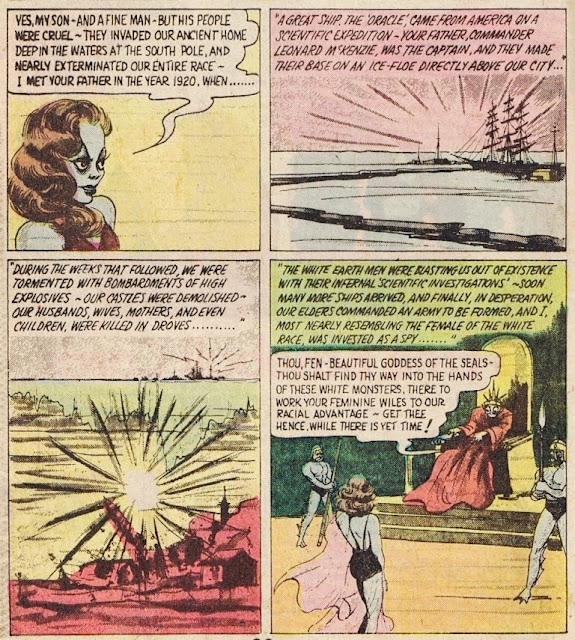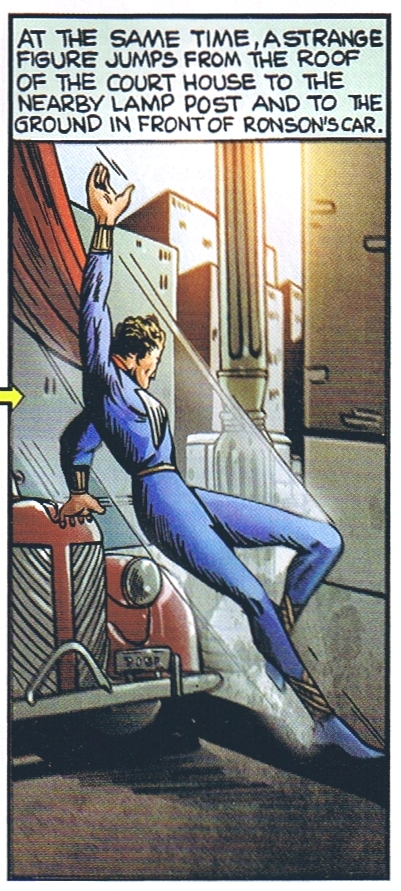| Marvel Comics #1, the 70th anniversary addition reprinting the classic comic with slick new painted cover and computer colored interior. |
Action Comics #1 with it’s first appearance of the hugely
popular character of Superman can be considered the most significant comic ever
published for having started the whole superhero fad that is still going on today and
popularizing the medium of comic books as a whole.
Action Comics #1 was such a hit that every publisher wanted in on this lucrative bandwagon. So in Oct. 1939 an unassuming comic was thrown together that would also have a big influence on the world of comics.
Marvel Comics #1 was a little different from the competitors. While it had fantastic super powered beings, they were not necessarily benevolent. While Superman kicked ass for justice; The characters of Marvel Comics, on the other hand, were wreaking havoc destroying our cities.
Chiefly among the Timely "heroes" (the publisher of Marvel Comics #1) was the Sub-Mariner drawn by the legendary Bill Everett, who had a bad vendetta against all surface dwellers.
Marvel Comics #1 was a little different from the competitors. While it had fantastic super powered beings, they were not necessarily benevolent. While Superman kicked ass for justice; The characters of Marvel Comics, on the other hand, were wreaking havoc destroying our cities.
Chiefly among the Timely "heroes" (the publisher of Marvel Comics #1) was the Sub-Mariner drawn by the legendary Bill Everett, who had a bad vendetta against all surface dwellers.
It seems that the surface dwellers had unwittingly been dumping their bombs on the Atlanteans for years.
So Namor, the Sub-Mariner was actually bred from humans to be his races redeemer and savior.
While most comics of the time were crudely drawn by teenagers, Bill Everett had a wonderfully detailed and lyrical style right from the beginning. The publishers really didn't care much for quality. Quantity was much more important because the comics were hot and they wanted to get out as many they could as fast as they could. Bill Everett was one of the best at that time and only seemed to get better with age.
Then there was the Human Torch drawn by Carl Burgos. Human Torch was actually a misnomer seeing as how he wasn't even human but rather an android that had the flaw of catching on fire whenever he was exposed to air.
He was imprisoned in a tube to protect humanity, though one night some oxygen got into his container and he escaped. Like a dog let off his leash, he ran rampant through the city causing all kinds of fire and destruction.
While most comics of the time were crudely drawn by teenagers, Bill Everett had a wonderfully detailed and lyrical style right from the beginning. The publishers really didn't care much for quality. Quantity was much more important because the comics were hot and they wanted to get out as many they could as fast as they could. Bill Everett was one of the best at that time and only seemed to get better with age.
Then there was the Human Torch drawn by Carl Burgos. Human Torch was actually a misnomer seeing as how he wasn't even human but rather an android that had the flaw of catching on fire whenever he was exposed to air.
He was imprisoned in a tube to protect humanity, though one night some oxygen got into his container and he escaped. Like a dog let off his leash, he ran rampant through the city causing all kinds of fire and destruction.
Some gangsters had the great idea to use him in an insurance scam but the Human Torch really didn't like being used that way and took revenge.
Carl Burgos wasn't the best artist but his work has an intimacy and immediacy that makes it very exciting to see. The pages are awkwardly drawn with a very complex, maze-like panel arrangement, often resorting to arrows to direct the reader as to the order of the panels, but the sentiment being expressed is pure and potent.
And then there was The Angel drawn by Paul Gustavson. Like Batman, he was a costumed crusader without any super powers who would use his brains and brawn to fight the mob and other criminals.
Despite his name he really isn’t much of an angel unless you are talking about the avenging kind. He seems to enjoy watching his opponents suffer and die.
The Human Torch and Subby would eventually end up adversaries fighting each other that would culminate in climatic battle in Marvel Mystery Comics #9.
Captain America would join the Timely Comics lineup and group of them would go onto even greater heights but that is a story for another time.
The heroes of Timely were gloriously seditious when they first appeared. This is one of the things that really excites me about early Golden Age comics. They reveled in dealing out just deserts and took joy in punishing the criminals. As the Golden Age comics became more popular, the publishers would dumb down and sweeten their comics to appeal to as wide an audience as possible. The very early Golden Age comics, on the other hand, were a much more pure expression of their creators vision. There was very little morality or pandering censoring the artists creativity. The early Golden Age comics were just pure excitement.
Carl Burgos wasn't the best artist but his work has an intimacy and immediacy that makes it very exciting to see. The pages are awkwardly drawn with a very complex, maze-like panel arrangement, often resorting to arrows to direct the reader as to the order of the panels, but the sentiment being expressed is pure and potent.
And then there was The Angel drawn by Paul Gustavson. Like Batman, he was a costumed crusader without any super powers who would use his brains and brawn to fight the mob and other criminals.
This strip has a much more realistic feel to it than most Golden Age comics. Paul Gustavson may not have known
superhero costumes very well but he sure knew the crime genre well. He depicts the clothes and cars of the time with a accuracy and style that was rare in the early Golden Age heroes.
Despite his name he really isn’t much of an angel unless you are talking about the avenging kind. He seems to enjoy watching his opponents suffer and die.
The Human Torch and Subby would eventually end up adversaries fighting each other that would culminate in climatic battle in Marvel Mystery Comics #9.
Captain America would join the Timely Comics lineup and group of them would go onto even greater heights but that is a story for another time.
The heroes of Timely were gloriously seditious when they first appeared. This is one of the things that really excites me about early Golden Age comics. They reveled in dealing out just deserts and took joy in punishing the criminals. As the Golden Age comics became more popular, the publishers would dumb down and sweeten their comics to appeal to as wide an audience as possible. The very early Golden Age comics, on the other hand, were a much more pure expression of their creators vision. There was very little morality or pandering censoring the artists creativity. The early Golden Age comics were just pure excitement.




















Namor was, thus, the very first comics anti-hero and both he and the original Human Torch could be very dangerous, even unintentionally killing people. And the fight between Namor & the Torch was, at least as far as I know, the comic story to feature two stars of independent series together, and in what would become a tradition at Marvel decades later, they did not get along very well! Lee clearly took much inspiration from what his Timely predecessors did.
ReplyDeleteI was diagnosed with Parkinson’s four years ago, and despite medications my symptoms kept worsening. Out of hope, I tried an herbal program from NaturePath Herbal Clinic, and within months my energy, balance, and confidence improved. It’s been life-changing I finally feel like myself again.visit their website at www.naturepathherbalclinic.com
ReplyDeleteinfo@naturepathherbalclinic.com